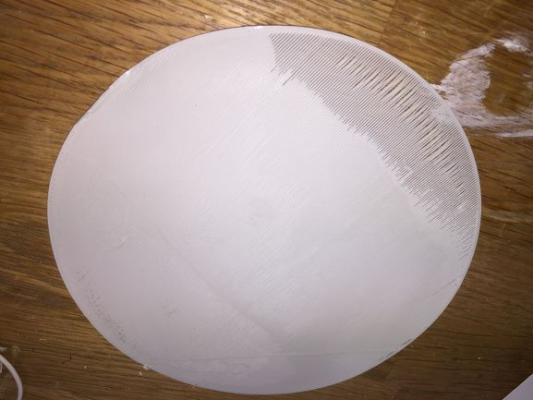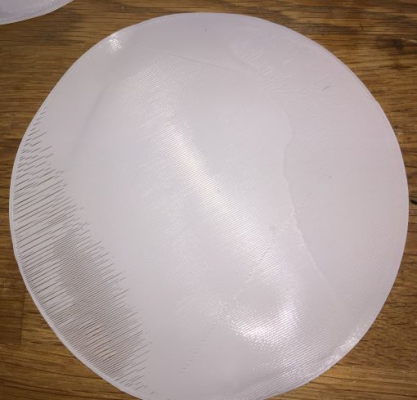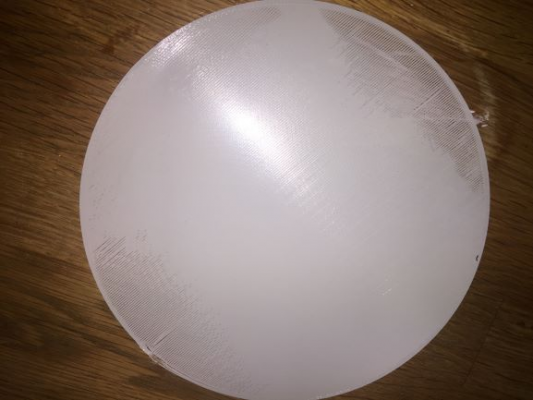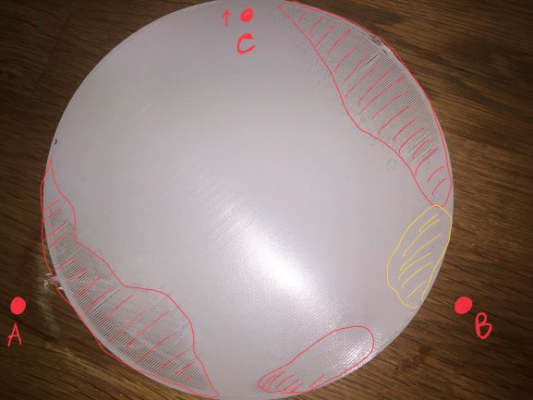Bed leveling / first layer calibration
Posted by theliadir
|
Bed leveling / first layer calibration August 23, 2020 01:41PM |
Registered: 4 years ago Posts: 12 |
I need help with the calibration of a delta printer (bed leveling). (Rostock - Marlin version 1.1.9 - Ramps 1.4)
I use this microswitch as a self-built Z-probe: [www.aliexpress.com]
(Marlin config.h file attached)
I had to replace the rods. While doing that I also reglued the rod end bearings and tried to make them the same length as good as possible.
I first calibrated the delta with G33.
Here is the calibration result:
Height: 490.48 Ex:+0.00 Ey:-0.27 Ez:-0.37 Radius:113.63
Tx:+0.11 Ty:+0.10 Tz:-0.21
(I did not yet copy these values to marlin. But they are stored in eeprom.)
I then tried these 3 bed leveling options:
//#define AUTO_BED_LEVELING_3POINT
//#define AUTO_BED_LEVELING_LINEAR
//#define AUTO_BED_LEVELING_BILINEAR
None of them really worked for me.
I always have an area where i have gaps because the nozzle is too far away from the bed.
Here are two examples of a print of a round circle with one layer (0.2mm). (with linear bed leveling)
The width of the printing bed is 200mm and these circles are 160mm.
The area with the gaps are near the A tower. On the opposite side there is a "line shift" which causes a visble structrul line. (I could live with that.)
Any ideas what I could try or change?
PS: When I look close to first layer print, I'd say that I need to manually tilt the print bed a bit to one side to resolve the issue. (Could I do that with DELTA_ENDSTOP_ADJ?)
But then again, the horizontal "layer shift" let me think that there is a problem with the delta geometry?
Thanks in advance for any help.
I use this microswitch as a self-built Z-probe: [www.aliexpress.com]
(Marlin config.h file attached)
I had to replace the rods. While doing that I also reglued the rod end bearings and tried to make them the same length as good as possible.
I first calibrated the delta with G33.
Here is the calibration result:
Height: 490.48 Ex:+0.00 Ey:-0.27 Ez:-0.37 Radius:113.63
Tx:+0.11 Ty:+0.10 Tz:-0.21
(I did not yet copy these values to marlin. But they are stored in eeprom.)
I then tried these 3 bed leveling options:
//#define AUTO_BED_LEVELING_3POINT
//#define AUTO_BED_LEVELING_LINEAR
//#define AUTO_BED_LEVELING_BILINEAR
None of them really worked for me.
I always have an area where i have gaps because the nozzle is too far away from the bed.
Here are two examples of a print of a round circle with one layer (0.2mm). (with linear bed leveling)
The width of the printing bed is 200mm and these circles are 160mm.
The area with the gaps are near the A tower. On the opposite side there is a "line shift" which causes a visble structrul line. (I could live with that.)
Any ideas what I could try or change?
PS: When I look close to first layer print, I'd say that I need to manually tilt the print bed a bit to one side to resolve the issue. (Could I do that with DELTA_ENDSTOP_ADJ?)
But then again, the horizontal "layer shift" let me think that there is a problem with the delta geometry?
Thanks in advance for any help.
|
Re: Bed leveling / first layer calibration August 23, 2020 02:23PM |
Registered: 10 years ago Posts: 732 |
Looks like only a bad endstop position on tower A. If the thickness of the first layer changes almost linearly depending on distance from A tower then it is almost for sure bad endstop position on tower A. You can try to adjust it manually with M666 command. I do not use Marlin any more and do not know the meaning of DELTA_ENDSTOP_ADJ.
If you can handle math than this can help you: [github.com]
If you can handle math than this can help you: [github.com]
|
Re: Bed leveling / first layer calibration August 23, 2020 02:33PM |
Registered: 5 years ago Posts: 83 |
I could never get auto calibration to give me good results. What I eventually figured out was the endstop calibration isn't that great without probeing well outside the print area. After I physically moved the endstops to be as close as possible to the seame height, I manually calibrated the endstops (M666). Then I ran auto calibration in a mode that calibrates everything except endstops. I had moved on from Marlin by the time I figured this out(had the same calibration issues with Marlin, Smoothie and RRF) but it seems like G33 has a number of options that might do the trick. Worth a shot.
|
Re: Bed leveling / first layer calibration August 29, 2020 07:39AM |
Registered: 4 years ago Posts: 12 |
Thank you guys.
So I tried to change the Endstop to get as close to 0 values for Ex, Ey, and Ez.
Here are the new values after autocalibrate: Ex: -0.103, Ey: -0.042, Ez: 0.000
(+/- 0.1 is good enough?)
Now the "line shifting" is gone and I have straight lines <3. BUT I still have gaps on two sides:
The nozzle is too high on these areas. Do I asume correctly that I have to adjust the delta radius? Or is my assumption incorrect?
I'd say I have to increase the radius?
Now the radius is 113.42 So I have to try with 113.52, 113.62 until its good? (Ar 0.1 steps too high or to low?)
@hercek: How can I start this script from github?
@thehankinator: You mean G33 PX? Which one did you use?
PS: In the wide middle area the print quality is near perfect. :-)
Thx for you help.
So I tried to change the Endstop to get as close to 0 values for Ex, Ey, and Ez.
Here are the new values after autocalibrate: Ex: -0.103, Ey: -0.042, Ez: 0.000
(+/- 0.1 is good enough?)
Now the "line shifting" is gone and I have straight lines <3. BUT I still have gaps on two sides:
The nozzle is too high on these areas. Do I asume correctly that I have to adjust the delta radius? Or is my assumption incorrect?
I'd say I have to increase the radius?
Now the radius is 113.42 So I have to try with 113.52, 113.62 until its good? (Ar 0.1 steps too high or to low?)
@hercek: How can I start this script from github?
@thehankinator: You mean G33 PX? Which one did you use?
PS: In the wide middle area the print quality is near perfect. :-)
Thx for you help.
|
Re: Bed leveling / first layer calibration August 29, 2020 10:16AM |
Registered: 5 years ago Posts: 83 |
I did it with RepRapFirmware but there should be a way to do it with Marlin. I probed the points right in front of the towers with G30 then manually adjusted the endstops with M666 until they were within about .05mm. It took 3 or 4 iterations to get there. Then I used 6 factor calibration for G32. I also ran bed leveling with G29.
I'm not sure G30 works the same in Marlin. For example if I adjust the X endstop with M666, I did not see that change reflected in the following G30. You should double check that though, maybe I got mixed up. Do you have the screws on the top of your carriages for endstop adjustment? If so that could make it a bit easier since it's a mechanical adjustment and you would leave M666 to 0. It isn't obvious to me which Marlin command is the equivalent to 6 factor calibration(everything but endstops) maybe G33 P3? I couldn't get mesh ABL to work with Marlin (2.0+).
I'm not sure G30 works the same in Marlin. For example if I adjust the X endstop with M666, I did not see that change reflected in the following G30. You should double check that though, maybe I got mixed up. Do you have the screws on the top of your carriages for endstop adjustment? If so that could make it a bit easier since it's a mechanical adjustment and you would leave M666 to 0. It isn't obvious to me which Marlin command is the equivalent to 6 factor calibration(everything but endstops) maybe G33 P3? I couldn't get mesh ABL to work with Marlin (2.0+).
|
Re: Bed leveling / first layer calibration August 29, 2020 02:43PM |
Registered: 10 years ago Posts: 732 |
@theliadir:
The scripts are for wxmaxima: [sourceforge.net]
There is no automatic connection of printer output to the scripts. One needs to understand the scripts enough to be able to feed probing data to them manually.
The two most interesting scripts are:
[*] towerErrors - this one enables you to simulate what is the impact of tower position or endstot errors on the first layer
[*] calibration - this allows you to feed probing data to the script and it will compute adjustments which need to be done to tower and endstop positions
For the second script, you need a firmware which can report tower positions at the probing point (otherwise you would need to modify the math in the script). I do not know whether any widespread firmwares do that. There are at least two which do that: [github.com] and [github.com] But they are behind form the feature point of view. I did not merge any recent changes.
If the math in the scripts feels complicated to you then I cannot really help. Dc42 had some web page which does something like the scripts for you in a way which requires less math knowledge. Sorry, I do not have the link. Try google.
The scripts are for wxmaxima: [sourceforge.net]
There is no automatic connection of printer output to the scripts. One needs to understand the scripts enough to be able to feed probing data to them manually.
The two most interesting scripts are:
[*] towerErrors - this one enables you to simulate what is the impact of tower position or endstot errors on the first layer
[*] calibration - this allows you to feed probing data to the script and it will compute adjustments which need to be done to tower and endstop positions
For the second script, you need a firmware which can report tower positions at the probing point (otherwise you would need to modify the math in the script). I do not know whether any widespread firmwares do that. There are at least two which do that: [github.com] and [github.com] But they are behind form the feature point of view. I did not merge any recent changes.
If the math in the scripts feels complicated to you then I cannot really help. Dc42 had some web page which does something like the scripts for you in a way which requires less math knowledge. Sorry, I do not have the link. Try google.
|
Re: Bed leveling / first layer calibration September 03, 2020 01:43AM |
Registered: 4 years ago Posts: 12 |
I ended up doing it manually with M666 and got a result with which I'm quite happy. It's not prefect but fine for now.
I did the first part with the paper method with 3-4 iteration and the second part with a print of a single layer circle.
Maybe I will try some automatic calibration like G32 or bed leveling later. But for now it's printing and I didnt come so far for a long time so Im satisfied for now.
Thx for your help.
Now I'm off to calibrate the printing quality. ^^
I did the first part with the paper method with 3-4 iteration and the second part with a print of a single layer circle.
Maybe I will try some automatic calibration like G32 or bed leveling later. But for now it's printing and I didnt come so far for a long time so Im satisfied for now.
Thx for your help.
Now I'm off to calibrate the printing quality. ^^
|
Re: Bed leveling / first layer calibration May 10, 2021 12:14PM |
Registered: 4 years ago Posts: 26 |
I have an HE3D K280 and have never been happy with doing auto bed leveling or calibration. I do everything manually using Repetier-Host.
I have the end stops on the towers set as close as possible to the same height, so the head is centered when homed.
In repetier I have the scripts set as follows to give me points 120 mm from the center near each tower. If you do not have the same size bed you may need to change the values for your bed size.
#1 is for A tower X-103.92 Y-60 Z0
#2 for B tower X103.92 Y-60 Z0
#3 for C tower X0 Y120 Z0
#4 for center X0 Y0 Z0
I first pick one tower and set the Z max travel in the firmware to match the bed height with paper thin clearance.
Once the first tower is set with proper clearance I move to the next tower and adjust the bed height, then finish with the third tower.
A final check at each tower to tweak as needed, then it is time to calibrate the center.
For center (flat travel) adjustment the rod length is used. If the center point is low then a longer rod setting raises it. If high then a shorter rod length lowers it. I adjust in small increments until the clearance at the center matches the tower point clearance.
Once that is all done then a simple 3 point check periodically to verify the bed has not shifted is all that is needed on a regular basis..
I have the end stops on the towers set as close as possible to the same height, so the head is centered when homed.
In repetier I have the scripts set as follows to give me points 120 mm from the center near each tower. If you do not have the same size bed you may need to change the values for your bed size.
#1 is for A tower X-103.92 Y-60 Z0
#2 for B tower X103.92 Y-60 Z0
#3 for C tower X0 Y120 Z0
#4 for center X0 Y0 Z0
I first pick one tower and set the Z max travel in the firmware to match the bed height with paper thin clearance.
Once the first tower is set with proper clearance I move to the next tower and adjust the bed height, then finish with the third tower.
A final check at each tower to tweak as needed, then it is time to calibrate the center.
For center (flat travel) adjustment the rod length is used. If the center point is low then a longer rod setting raises it. If high then a shorter rod length lowers it. I adjust in small increments until the clearance at the center matches the tower point clearance.
Once that is all done then a simple 3 point check periodically to verify the bed has not shifted is all that is needed on a regular basis..
Sorry, only registered users may post in this forum.



